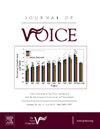使用声门上气道装置进行短期麻醉时,吸入麻醉与全静脉麻醉对嗓音影响的比较。
IF 2.5
4区 医学
Q1 AUDIOLOGY & SPEECH-LANGUAGE PATHOLOGY
引用次数: 0
摘要
目的:在短期麻醉应用中,声门上气道装置(SAD)是气管内插管(ETI)的良好替代品,因为它们具有应用简便、成本较低、可实现自主通气等优点。全静脉麻醉(TIVA)和可快速恢复的地氟醚麻醉是应选择的麻醉方法。吸入地氟醚麻醉可能会对气道粘膜和声带功能造成不良影响。本研究旨在比较所选麻醉方法对接受 SADs 短期麻醉的妇科患者嗓音的影响:材料: 妇产科门诊计划进行短期手术的74名患者被随机分为两组,分别接受地氟醚麻醉(D组)和TIVA麻醉(T组)。麻醉前通过喉部检查进行语音记录。记录围术期血液动力学参数、气道并发症和术后气道并发症。麻醉后 24 小时后进行第二次喉部检查和语音记录。通过 Praat 程序对患者的声音分析进行评估。对麻醉后咽喉疼痛、吞咽困难和声音嘶哑等情况进行了调查。比较了患者嗓音的声学和空气动力学特性、气道并发症以及与使用 SAD 相关的咽喉不适:结果:两组患者的人口统计学数据无明显差异。SAD的类型和大小具有相似的特征。T 组和 D 组在麻醉持续时间方面无明显差异(P = 0.964)。两种麻醉方法对咽喉功能和声音的影响相似。除声学分析的闪烁值外,T 组和 D 组在其他参数上无明显差异。而 D 组的微光变量在统计学上有明显增加(P < 0.05)。T组和D组在气道并发症、咽喉痛、吞咽困难和声音嘶哑方面没有明显差异:结论:TIVA和地氟醚麻醉在通过SAD进行的妇科短期手术中对嗓音和咽喉发病率有相似的临床效果。D 组声学嗓音分析的闪烁值增加表明,地氟醚麻醉可能会导致临床上不明显的嗓音恶化。要证明麻醉剂对使用 SAD 的患者喉功能的影响,还需要进一步的综合研究。本文章由计算机程序翻译,如有差异,请以英文原文为准。
The Comparison Between Inhalation and Total Intravenous Anesthesia Effect on Voice With Supraglottic Airway Devices for Short-term Anesthesia
Objective
Supraglottic airway devices (SADs) are a good alternative to endotracheal intubation (ETI) in short-term anesthesia applications since they have advantages including easy application, lower cost, enabling spontaneous ventilation. Total intravenous anesthesia (TIVA) and desflurane anesthesia allowing rapid recovery are anesthesia methods to be selected. Inhalation anesthesia by desflurane may cause adverse effects on airway mucosa and vocal cord functions. The aim of the present study was to compare the effect of the chosen anesthesia method on voice in gynecological patients who underwent short-term anesthesia with SADs.
Material and method
Seventy four patients whom short-term surgical procedure was planned in the Gynecology and Obstetrics Clinic were randomized into two groups for desflurane anesthesia (group D) and TIVA (group T). Voice recording was performed through larynx examination before anesthesia. Perioperative hemodynamic parameters, airway complications and postoperative airway complications were recorded. Laryngeal examination and voice recording were performed for the second time after 24 hours following the anesthesia procedure. Acoustic voice analysis of the patients was evaluated through the Praat program. The conditions including sore throat, dysphagia, and hoarseness were investigated after the anesthesia. Acoustic and aerodynamic properties of the voice, airway complications and pharyngolaryngeal complaints related to the use of SADs were compared in the patients.
Result
There was not any significant difference between the groups for demographic data. The SADs type and size have similar characteristics. No significant difference was detected between Group T and Group D for anesthesia duration (P = 0.964). Both anesthesia methods cause similar effects on pharyngolaryngeal functions and voice. No significant difference was found between Group T and Group D in parameters other than the shimmer value of acoustic analysis. A statistically significant increase was observed in the Shimmer variable of group D (P < 0.05). When group T and group D were compared, there was not any significant difference in terms of airway complications, sore throat, dysphagia, and hoarseness.
Conclusion
The TIVA and desflurane anesthesia presented similar clinical effects on voice and pharyngolaryngeal morbidity in the short-term gynecological operations through SADs. The increased shimmer value of acoustic voice analysis in Group D suggests that desflurane anesthesia may cause clinically insignificant deterioration on the voice. Further comprehensive studies are needed in order to demonstrate the effect of anesthetic agents on larynx functions in patients whom SADs is used.
求助全文
通过发布文献求助,成功后即可免费获取论文全文。
去求助
来源期刊

Journal of Voice
医学-耳鼻喉科学
CiteScore
4.00
自引率
13.60%
发文量
395
审稿时长
59 days
期刊介绍:
The Journal of Voice is widely regarded as the world''s premiere journal for voice medicine and research. This peer-reviewed publication is listed in Index Medicus and is indexed by the Institute for Scientific Information. The journal contains articles written by experts throughout the world on all topics in voice sciences, voice medicine and surgery, and speech-language pathologists'' management of voice-related problems. The journal includes clinical articles, clinical research, and laboratory research. Members of the Foundation receive the journal as a benefit of membership.
 求助内容:
求助内容: 应助结果提醒方式:
应助结果提醒方式:


